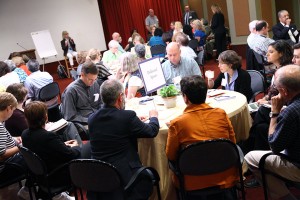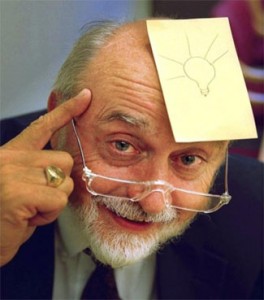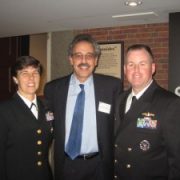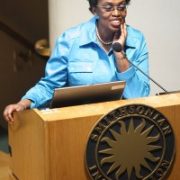Thank you to everyone who traveled to Washington, D.C. in June to join us for the Smithsonian Affiliations National Conference. So much happened in just 3 short days! We don’t want anyone to feel left out, so we’ve created a conference recap and included links to important information you may have missed.
Click here to view 2011 Conference photos on our Flickr site and add your own!

Welcome Reception in the Smithsonian Castle Commons. Photo by Smithsonian Affiliations.
Day 1, Monday, June 13: The 2011 Smithsonian Affiliations National Conference opened with a bang at the Smithsonian Castle. During Orientation in the Castle Library, attendees reunited with fellow Affiliates and met new staff members from recently affiliated organizations. Affiliations Director, Harold Closter, discussed the advantages of partnering with the Smithsonian. Click here to view the Orientation session PowerPoint presentation.
We wrapped-up the first day with a Welcome Reception in the Smithsonian Castle Commons. Special guest Sidney Mobell thanked Affiliates and the Smithsonian for hosting Jeweled Objects of Desire, a traveling exhibition based on his jeweled art creations, which over the years has traveled to six Affiliates and is in the National Gem Collection at the National Museum of Natural History. Interested in hosting the exhibition? Contact your National Outreach Manager.

Photo by tony brown/imijphoto.com
Day 2, Tuesday, June 14: Focusing on education at this year’s conference, we invited Claudine Brown, Assistant Secretary for Education and Access, to be our Keynote Speaker. She spoke on the future of education at the Smithsonian, the role of partnerships in advancing the work of Affiliates, and challenged Affiliates and the Smithsonian to expand education and access. “At the Smithsonian, our collections and exhibitions inspire. Our people teach and our programs help students apply what they have learned. We aspire to be a veritable educational engine, using the resources of America’s museum to create a stronger, better America for our children to inherit. Through our National Outreach Programs, we will expand our exhibition-based education programs to cities and towns across the country.” Click here to view Claudine Brown’s Keynote Address PowerPoint.

Photo by tony brown/imijphoto.com
Following Claudine Brown’s keynote, attendees were invited to brainstorm collaborative ideas in education in the roundtable session What’s the Big Idea: Revitalizing Education Through Partnership and Collaboration. From education technology to dedicated spaces, early childhood education to programs in your own backyard, there was ample opportunity to discuss the “big ideas” and then share them at the end of the session. What was shared? Click here to find out.
The afternoon was filled with sessions introducing new initiatives, increasing membership, expanding mobile platforms and STEAM programming. We wound down the day with a curator-led tour of the exhibition Buffalo Bill’s Wild West Warriors: A Photographic History by Gertrude Käsebier.
Click on the links below for the PowerPoint presentations from each session:
An Introduction to “The Immigration Initiative: Exploring and Presenting America’s Cultural History of Migration and Immigration.” –Fath Davis Ruffins, Curator of African American History and Culture, National Museum of American History
Building and Increasing Membership: A Museum-Wide Approach–Christina Di Meglio Lopez, Business & External Affairs Manager, Smithsonian Affiliations; Meg Colafella, Director of Membership, Senator John Heinz History Center
You CAN Take It With You: A Practical Look at All Things Mobile–Nancy Proctor, Head of Mobile Strategy & Initiatives, Smithsonian Institution
Success with Science: New Approaches for New Audiences–Tricia Edwards, Education Specialist, Lemelson Center for the Study of Invention and Innovation, National Museum of American History; Judy Brown, Senior Vice President, Programs, Miami Science Museum.

Photo by tony brown/imijphoto.com
Day 3, Wednesday, June 15: The final day of the conference may have been the most exciting of the three days! National Museum of the American Indian Chef Richard Hetzler started the day off with a cooking demonstration and book signing of his cookbook, The Mitsitam Café Cookbook. After the demonstration, several Affiliate attendees shared how they use food to connect with their visitors and Chef Hetzler was enthusiastic about traveling to Affiliate venues for cooking demonstrations and book signings. Want to book Chef Hetzler? Contact your National Outreach Manager.
Following breakfast, conference attendees met with Smithsonian staff at four museums–National Air and Space Museum, National Museum of American History, National Museum of African Art, and National Museum of Natural History–to get a behind-the-scenes look at the Smithsonian loan process. Have a loan policy question? Contact your National Outreach Manager.
In the afternoon, attendees hopped on a bus and took a guided tour of the Anacostia neighborhood before meeting with staff at the Anacostia Community Museum to discuss museum issues at the community level and get a guided tour of the exhibition Word, Shout, Song.
And to top it all off, senators, representatives and Capitol Hill staffers joined Smithsonian Secretary G. Wayne Clough and Affiliates at the congressional reception at the Rayburn House Office Building.
Browse through our conference guidebook here.
Have questions about any of the sessions? Want to contact a Smithsonian staff member from the Resource Fair, or another Affiliate you met during the Conference? Contact your National Outreach Manager who will be happy to assist you!
Here’s what Affiliates said about the conference:
“It was positively exhilarating!”–Natalie De Riso, Community Programs Manager, Heinz History Center
“Thank you so much for an excellent Smithsonian affiliation conference, we all came back full of ideas and inspiration!”–Carmen Fishler, Director, Universidad del Turabo
“I brought back a lot of great ideas and contacts. I think the most important thing I came away from the conference with is a renewed feeling of excitement. It was inspiring to see all the good work people are doing both at the Smithsonian, and at all the sibling museums. Altogether an excellent experience and I’m looking forward to next year.”–David Unger, Director of Interpretation, American Textile History Museum
“I thought it was an excellent conference and a great introduction to the Affiliates program. Thanks for all the efforts everyone made to have a successful conference.”–Will Ticknor, Director of Museums, City of Las Cruces


























